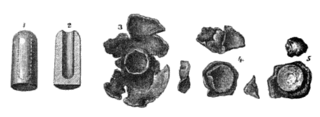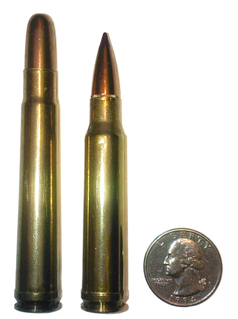
The term express was first applied to hunting rifles and ammunition beginning in the middle 19th century, to indicate a rifle or ammunition capable of higher than typical velocities. The early express cartridges used a heavy charge of black powder to propel a lightweight, often hollow point bullet, at high velocities to maximize point blank range. Later the express cartridges were loaded with nitrocellulose based gunpowder, leading to the Nitro Express cartridges, the first of which was the .450 Nitro Express.
The Nitro Express (NE) series of cartridges are used in large-bore hunting rifles, also known as elephant guns or express rifles, but later came to include smaller bore high velocity British cartridges.
The .600 Nitro Express is a large bore Nitro Express rifle cartridge developed by W.J. Jeffery & Co for the purpose of hunting large game such as elephant.
The .577 Nitro Express is a large bore centerfire rifle cartridge designed for the purpose of hunting large game such as elephant. This cartridge is used almost exclusively in single shot and double express rifles for hunting in the Tropics or hot climates in general and is a cartridge associated with the Golden Age of African safaris and Indian shikars.

The .375 H&H Magnum also known as .375 Holland & Holland Magnum is a medium-bore rifle cartridge introduced in 1912 by London based gunmaker Holland & Holland. The .375 H&H cartridge featured a belt to ensure the correct headspace, which otherwise might be unreliable, given the narrow shoulder of the cartridge case. The cartridge was designed to use cordite which was made in long strands – hence the tapered shape of the case, which, as a beneficial side effect also helped in smooth chambering and extraction from a rifle's breech.
The 9.5×57mm Mannlicher–Schönauer (MS) cartridge was adopted for the M-1910 MS rifle and carbine in 1910.. The 9.5×57mm MS is also known as the 9.5×56mm MS, the 9.5×56.7mm MS, and the .375 Rimless Nitro Express (RNE) × 2¼. The cartridge may have been created by Westley-Richards and Eley in 1908, but no production rifles in this caliber have been found prior to the M-1910. This development by or on behalf of Steyr was probably an answer to the development by the noted British gunmaking firm of Holland & Holland in 1905 of their .400/375 Belted Nitro Express, designed for their specially modified Mannlicher–Schoenauer rifle. Whether the development of the 9.5×57mm Mannlicher–Schoenauer cartridge originated with OWS or with Holland's British competitor, Westley Richards certainly was the principal promoter of the new 1910 Model Mannlicher–Schoenauer rifle as evidenced by catalogs of the time. The 9.5×57mm MS is the last pre-war proprietary cartridge by Steyr and their most powerful until the recent advent of the .376 Steyr, which has its antecedents in the 9.5×57mm.
.450 Nitro Express also known as the .450 Nitro Express 3¼-inch is a rifle cartridge designed for hunting dangerous game such as elephant, rhino, cape buffalo, lion, and leopard. This cartridge is used almost exclusively in double rifles for hunting in the Tropics or hot climates in general and is associated with the Golden Age of African safaris and Indian shikars.

The .505 Gibbs cartridge was designed by George Gibbs in 1911. The cartridge was originally known as the .505 Rimless Nitro Express. The C.I.P. refers to the cartridge as the 505 Mag. Gibbs in their publications. It is a .50 caliber (12.8 mm) rimless bottlenecked cartridge intended for magazine-fed rifles.

The .404 Jeffery is a rifle cartridge designed for hunting large, dangerous game animals, such as the "Big Five" of Africa. The cartridge is standardized by the C.I.P. and is also known as .404 Rimless Nitro Express. It was designed in 1905 by London based gunmaker W.J. Jeffery & Co to duplicate the performance of the .450/400 Nitro Express 3-inch in bolt-action rifles. The .404 Jeffery fired a bullet of .422 in diameter of either 300 gr (19 g) with a muzzle velocity of 2,600 ft/s (790 m/s) and muzzle energy of 4,500 foot-pounds force (6,100 N⋅m) or 400 gr (26 g) with a muzzle velocity of 2,150 ft/s (660 m/s) and 4,100 foot-pounds force (5,600 N⋅m) of energy. It is very effective on large game and is favored by many hunters of dangerous game. The .404 Jeffery was popular with hunters and game wardens in Africa because of good performance with a manageable recoil. By way of comparison, the .416 Rigby and .416 Remington Magnum cartridges fire a .416 in bullet of 400 gr at 2,400 feet per second (730 m/s) with a muzzle energy of approximately 5,000 foot-pounds force (6,800 N⋅m). These cartridges exceed the ballistic performance of the .404 Jeffery but at the price of greater recoil and in the case of the .416 Rigby, rifles that are more expensive.
The .475 Nitro Express is a British rifle cartridge developed in the early 20th century.
The .475 No 2 Nitro Express is a British rifle cartridge developed by Eley Brothers in the early 20th century.
The .500 Jeffery is a big-game rifle cartridge that first appeared around 1920, and was originally introduced by the August Schuler Company, a German firm, under the European designation "12.7×70mm Schuler" or ".500 Schuler". When offered by the famed British outfitter W.J. Jeffery & Co, it was renamed the .500 Jeffery so as to be more palatable to British hunters and sportsmen following World War One.
The .400 Jeffery Nitro Express or .450/400 Nitro Express 3-inch is a medium bore, bottlenecked, Nitro Express cartridge designed by W.J. Jeffery & Co in 1902, intended for use in single shot and double rifles.

The .318 Westley Richards, also known as the .318 Rimless Nitro Express and the .318 Accelerated Express, is a proprietary medium bore centerfire rifle cartridge developed by Westley Richards.
The .350 Rigby and .350 Rigby No 2 are proprietary medium bore rifle cartridges developed by developed by John Rigby & Company.
The .450 No 2 Nitro Express also known as the .450 Nitro Express 3½-inch was developed by Eley Brothers in 1903.
The .400/350 Nitro Express, also known at the .400/350 Nitro Rigby, is a medium bore rifle cartridge developed by John Rigby & Company.
The .450 Black Powder Express also known as the .450 31⁄4-inch BPE was a popular black powder cartridge in the late 19th and early 20th century.
The .400 Purdey, also known as the .400 3-inch Straight and .400 Purdey Light Express 3-inch, is an obsolete rifle cartridge developed by James Purdey & Sons.
The .400/360 Nitro Express cartridges are a number of very similar, but not interchangeable, centerfire rifle cartridges developed by James Purdey & Sons, William Evans, Westley Richards and Fraser of Edinburgh, all at the beginning of the 20th century.




